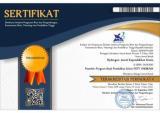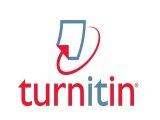Pengembangan Bahan Ajar Laju Reaksi Dengan Multipel Representasi Berbasis Inkuiri
Abstract
inquiry-based representation modules in the reaction rate material through the
ADDIE stage (Analyze, Design, Development Implementation and Evaluation)
developed by Thiagarajan. This research and development was carried out until
the development stage with adjustments based on development needs. The
assessment instrument used to determine the feasibility of the module is a
questionnaire sheet. The module feasibility was assessed by 2 material experts, 1
media expert, 1 linguist, 1 colleague, 1 practitioner, and 10 students as subjects.
Students involved in this study came from chemistry education study programs
that had undergone basic chemistry courses through limited trials. The data on
the value of the grievances obtained are still in the form of qualitative data and
then processed into quantitative data. Quantitative data are analyzed for each
aspect of the assessment. The final score obtained is converted to the level of
product feasibility qualitatively with the guidelines according to the criteria of
the assessment category. The results of expert validation showed the average
percentage (a) of material experts was 84% with very feasible categories; (b)
media experts 90% with very decent categories; (c) linguists 97% with very
decent categories; (d) colleagues 79.6 categories worth%; (e) practitioners
86.4% are very decent categories. The average response of students to product
development results 89.5% with a very feasible category. This shows that the
modules developed are feasible to be used at the stage of large-scale trials.
Keywords
Full Text:
PDFReferences
Cheng, M. & Gilbert, J.K. (2009).Toward a better utilization of diagrams in research into the
use of representative levels in chemical education. In: J.K. Gilbert & D. Treagust (Eds).
Multiple Representations in Chemical Education: Models and Modeling in Science
Education. Dordrecht: Springer. pp. 251-28.
Cracolice, M.S. (2009). Guided inquiry and learning cycle. Norbet J. Pienta, Melanie M.
Cooper, & Thomas J. Greenbowe (Eds), Chemist’s Guide to Effective Teaching Volume II
(page. 20−33). New Jersey: Pearson Education Inc.
Dewi, N.L. Dantes, N & Sadia, W. (2013).Pengaruh Model Pembelajaran Inkuiri Terbimbing
Terhadap Sikap Ilmiah dan Hasil Belajar IPA.e-Journal Program Pascasarjana
Universitas Pendidikan Ganesha Jurusan Pendidikan Dasar.(Volume 3 Tahun 2013).
Farida, I. (2012). Interkoneksi Multipel Level Representasi Mahasiswa Calon Guru Pada
Kesetimbangan Dalam Larutan Melalui Pembelajaran Berbasis Web.Program Studi
Pendidikan IPA Sekolah Pascasarjana Universitas Pendidikan Indonesia Bandung.
Effendy, (2008).Teori VSEPR (Kepolaran dan Gaya Antarmolekul) Edisi 3. Malang
Bayumedia.
Eilks, I., Moelering, M., & Valanides, N.(2007). Seventh-Grade Students Understanding of
ChemicalReactions: Reflections from an Action Research Interview Study, Eurasia
Journal of Mathematics, Science & Technology Education, Vol. 3, No. 4, Hal. 271-286.
Gilbert, J.K. & Treagust, D. (2009).Multiple Representations in Chemical Education: Models
and Modeling in Science Education. Dordrecht: Springer. pp. 251-283.
Johnstone, A.H. (2000). Teaching of Chemistry - Logical or Psycological?,Chemistry
education: Research and Practice in Europe. Vol. 1. No.1, Hal 9-15.
Kirik, O.T & Boz, Y. (2012). Cooperative Learning Instruction For Conceptual Change In
The Concepts Of Chemical Kinetics. RSC. Pract, 2012, 13, 221–236.
Perna , J. & Aksela, M. (2008).Concept Maps as Meaningful Learning Tools in A Web–
Based Chemistry material, Concept Mapping: Connecting EducatorsProc. of the Third
Int.Conference on Concept Mapping.
Riduwan. (2013). Skala Pengukuran Vaiabel-Variabel Penelitian. Bandung: Alfabeta.
Rizal, Muhammad. (2014). Pengaruh Pembelajaran Inkuiri Terbimbing dengan Multi
Representasi terhadap Keterampilan Proses Sains dan Penguasaan Konsep IPA Mahasiswa
SMP.Jurnal Pendidikan Sains. Vol. 2 No.3, 159-165.
Sa’adah, Effendy & Ibnu, S. (2016). Pengaruh Penerapan Pembelajaran Inkuiri Terbimbing
Terhadap Hasil Belajar Mahasiswa Pada Materi Bentuk Molekul. Prosiding Seminar Nasional Kimia dan Pembelajarannya (SNKP).27 November 2016 Aula FMIPA
Universitas Negeri Malang.
Suhandi, A & Wibowo, F.C. (2012).Pendekatan Multirepresentasi Dalam Pembelajaran
Usaha-Energi dan Dampak Terhadap Pemahaman Konsep Mahasiswa.Jurnal Pendidikan
Fisika Indonesia. Vol. 8, No.1, 1-7.
Tasker, R., & Dalton, R. (2006). Research into Practice: Visualisation of the Molecular
World Using Animations, Chemistry Education Research and Practice, Vol. 7, No. 2,
Hal.141-159.
Thiagarajan, S., Semmel, D.S., & Semmel, M.I. (1974). Instructional Development for
Training Teachers of Exceptional Children. Indiana: Indiana University Bloomington.
Trout, L., Lee C., Moog, R., & Rickey D., (2008). Inquiry Learning: What Is It? How Do
You Do It?. Dalam Bretz, S. L. (Ed.), Chemistry in The National Science Education
Standards: Model forMeaningful Learning in The High School Chemistry Classroom
Second Edition (hlm. 29-43). Washington: American Chemical Society.
DOI: https://doi.org/10.33394/hjkk.v6i1.1598
Refbacks
- There are currently no refbacks.

This work is licensed under a Creative Commons Attribution-ShareAlike 4.0 International License.





